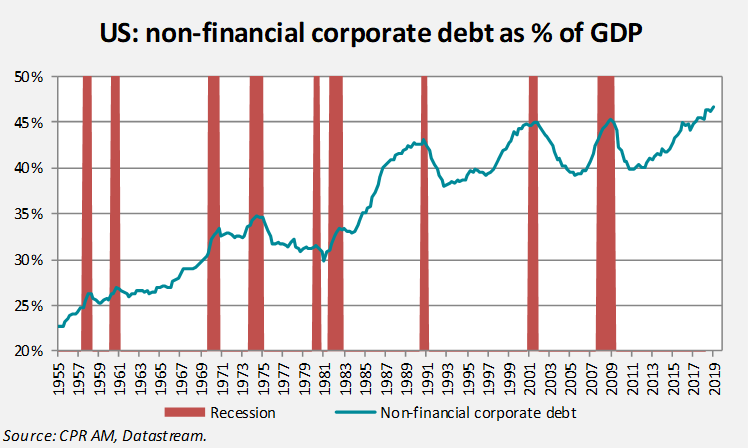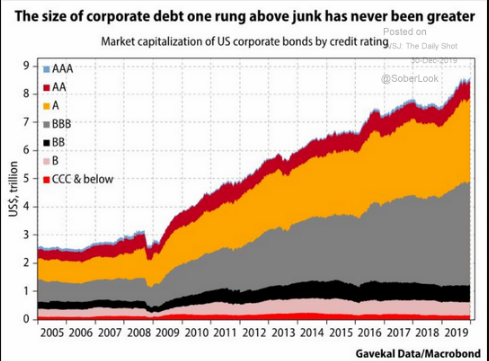Debt is never a bad thing if it is used to create organic growth or fund infrastructure development that creates opportunities and employment. Debt is dangerous when used to develop grotesque weapons of mass financial destruction by structuring synthetic derivative products that use leverage of 300 to 1 or more – meaning that $1 million can control $300 million in assets.

US corporate debt has swelled to nearly 10 trillion dollars. Coronavirus has created the economic conditions that will pop the corporate debt bubble after a decade of inflating. The amount of low-quality corporate debt that has been issued is unprecedented and will have far reaching consequences as the bond market declines. On 9th April 2020, Fed announced that it will be buying junk bond ETFs, this was quite a shock considering the level of risk the Fed is exposing itself to. Junk bonds are such garbage that the pension funds are prohibited by law from purchasing them. The Federal Reserve purchasing corporate bonds, let alone junk bonds, is in direct violation of the Federal Reserve Act of 1913. That law has been thrown away with the inception of the stimulus package to fight coronavirus through a special purpose vehicle using which, the Federal Reserve can buy corporate debt and put it on the Treasury’s balance sheet—if you take this argument to the extreme, the financial markets have been nationalized, and this is something that is extremely difficult to wrap your head around.

As severe and swift this crisis is, the US Fed has said that they are going to set the law aside and look the other way and find a workaround so that they can make sure that there is not a full-blown meltdown in the corporate debt market. Ironically, this situation was facilitated by the Federal Reserve Policies by keeping interest rates low for far too long; the US corporate Bond debt wouldn’t have doubled to 10 trillion dollars if the Fed had not repressed interest rates for such a long period in the first place.

Fed officials do not want to deal with the same public scrutiny, banker bashing and inquiries it stonewalled after the 2008 bank bailouts. In 2008, The Fed didn’t bailout the Lehman Brothers because they said it was ‘illegal’ to do so. The majority of the US’ massive debt pile was accrued over the last twelve years, when the missteps of the Federal Reserve’s 1998, 2001 and 2008 bailouts took interest rates to zero. This devastated prudent savers, created the most significant wealth inequality gap in history, and generated the largest pool of Wall Street billionaires before and after each crisis and bailout. The Federal Reserve bailouts have destroyed capitalism and they have never been held to account. The Fed’s actions have created an adulterated form of capitalism that, as far as financial oligarchs are concerned, has no losers, except taxpayers and future generations.
The Fed has been both the arsonist and the firefighter.
By,
Raghav Agarwal
Citations:
Bohn, H. (2011). The Economic Consequences of Rising U.S. Government Debt: Privileges at Risk. FinanzArchiv / Public Finance Analysis, 67(3), 282-302. Retrieved May 2, 2020, from www.jstor.org/stable/41303592
•Schwarcz, Steven L., Rollover Risk: Ideating a U.S. Debt Default (January 30, 2014). Boston College Law Review, Vol. 55, No. 1, p.1 2014. Available at SSRN: https://ssrn.com/abstract=2307569 or http://dx.doi.org/10.2139/ssrn.2307569
•Vuletic, Dominik, Next Global Crisis: Greatest Recession in the History of Capitalism is at the Doorstep (September 21, 2015). Available at SSRN: https://ssrn.com/abstract=2663630 or http://dx.doi.org/10.2139/ssrn.2663630
•Lo Duca, Marco and Nicoletti, Giulio and Martinez, Ariadna, Global Corporate Bond Issuance: What Role for US Quantitative Easing? (February 18, 2014). ECB Working Paper No. 1649. Available at SSRN: https://ssrn.com/abstract=2397787
